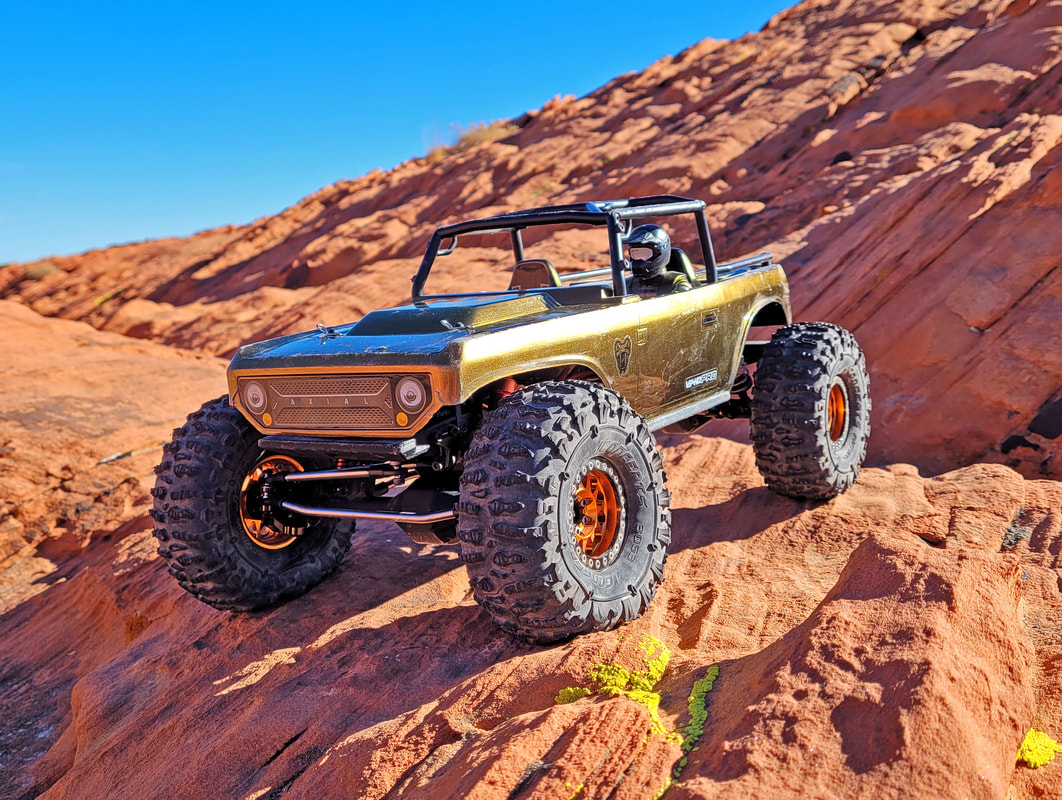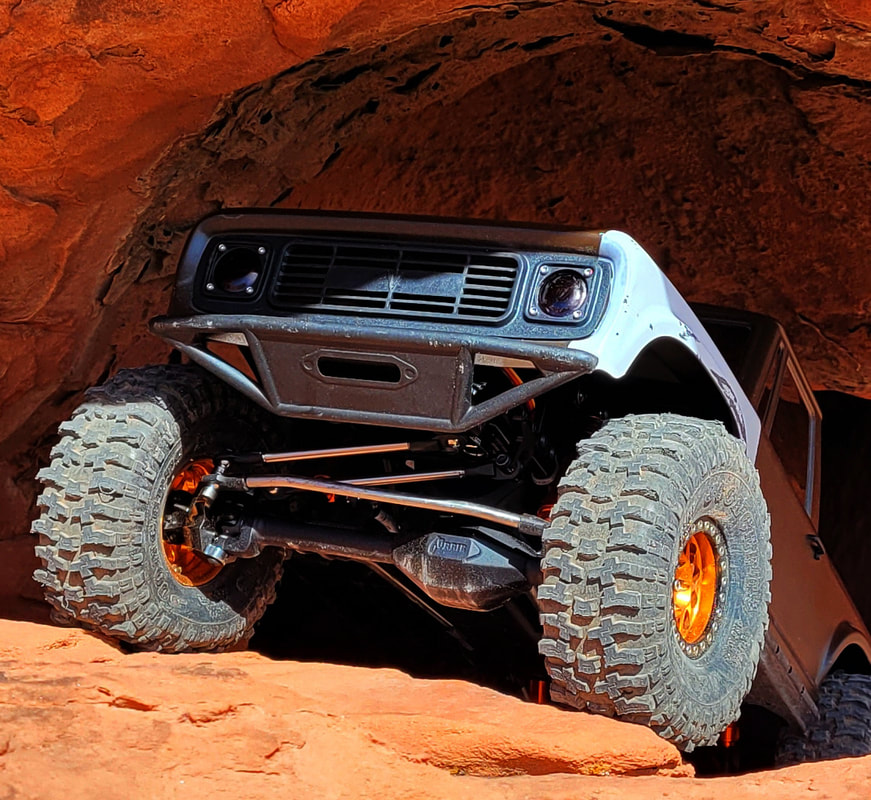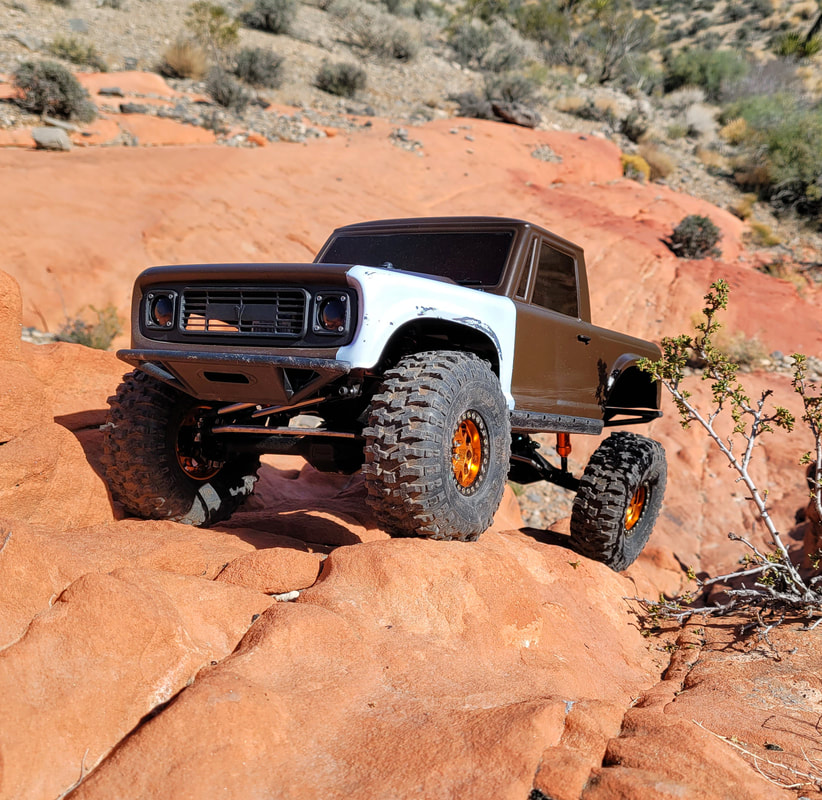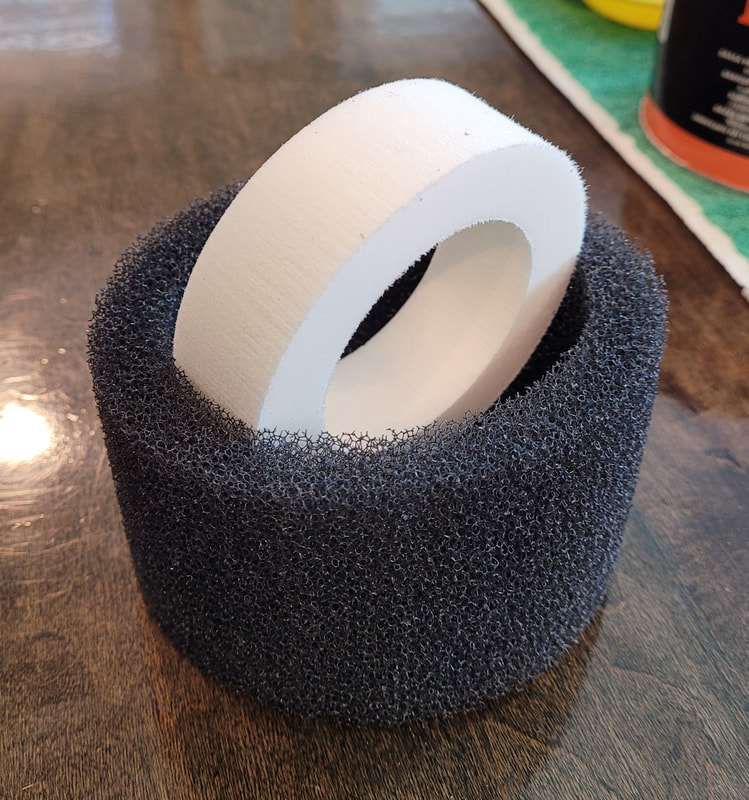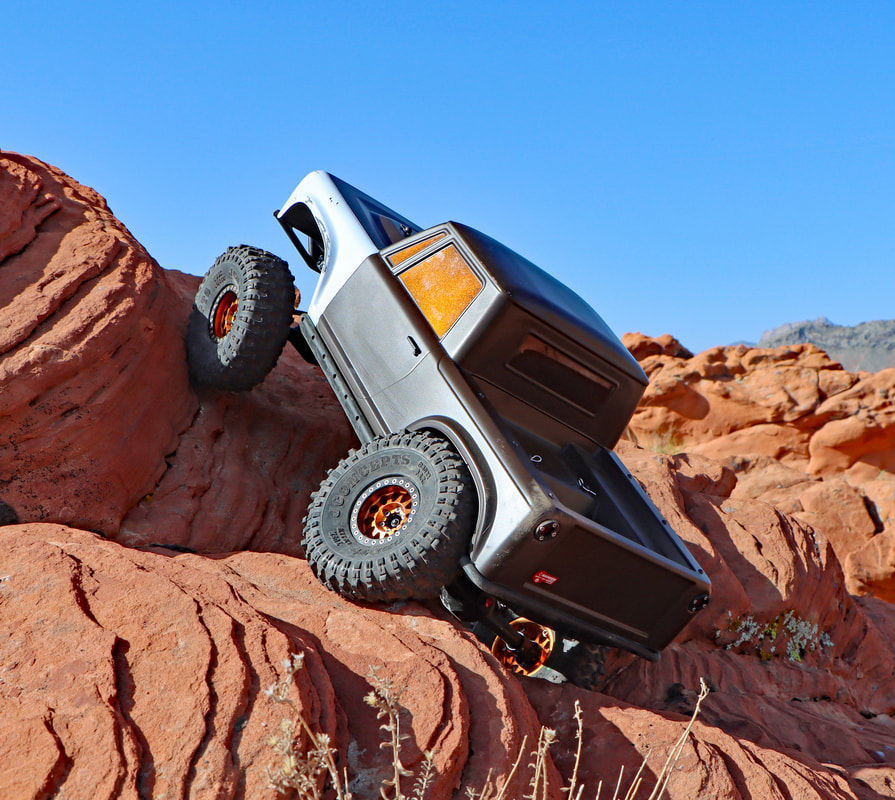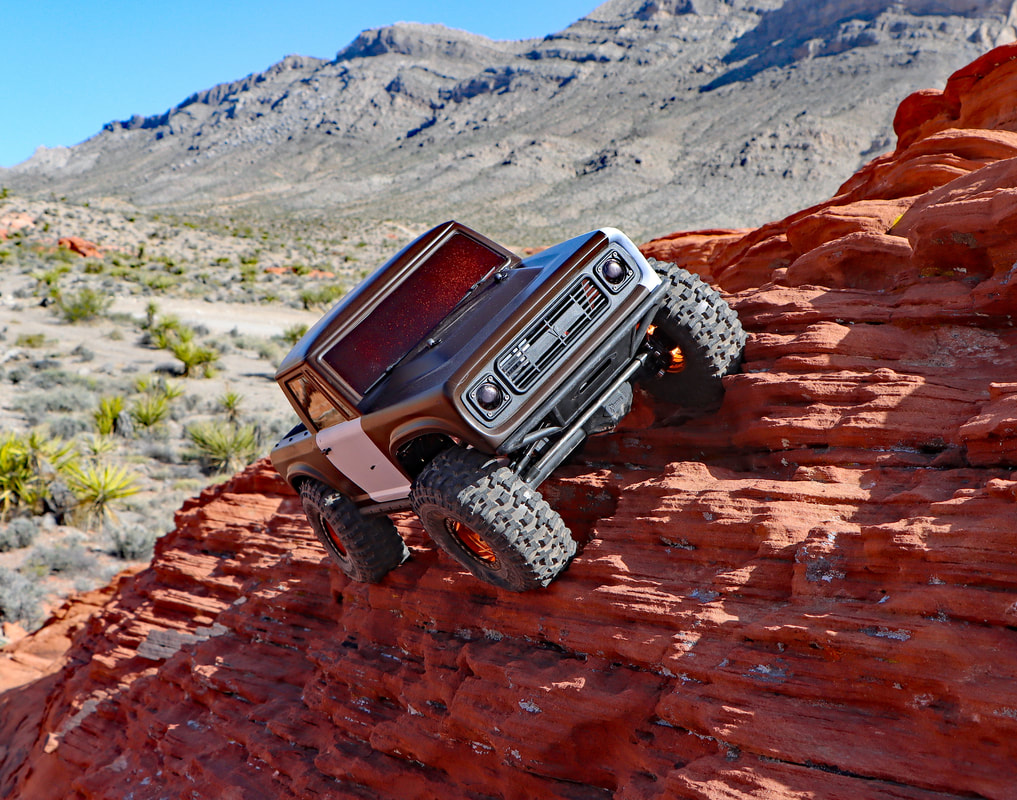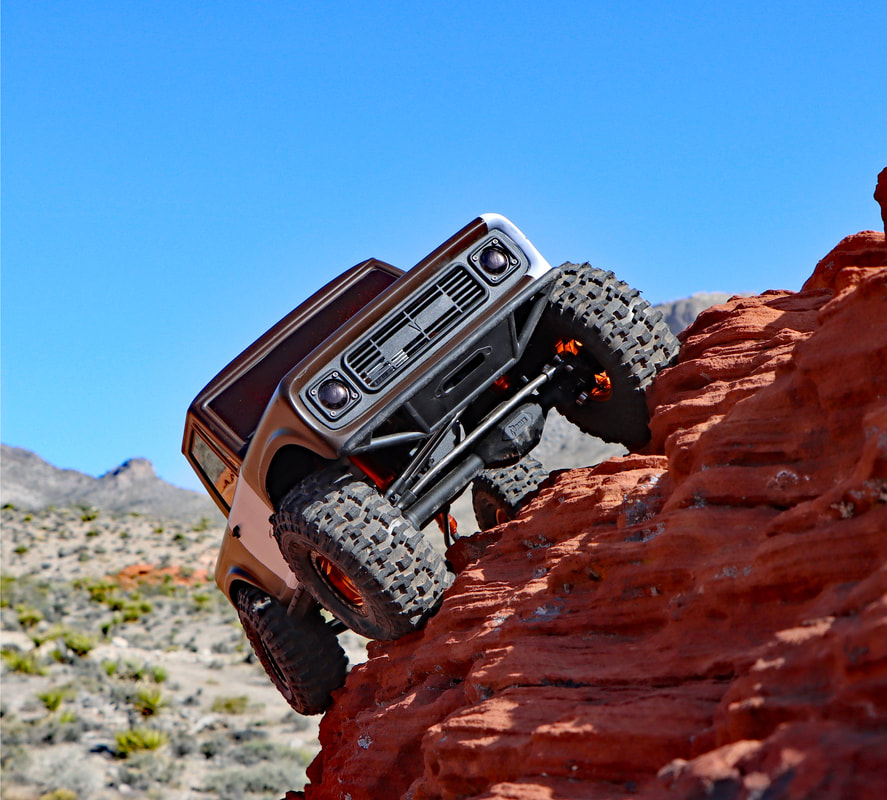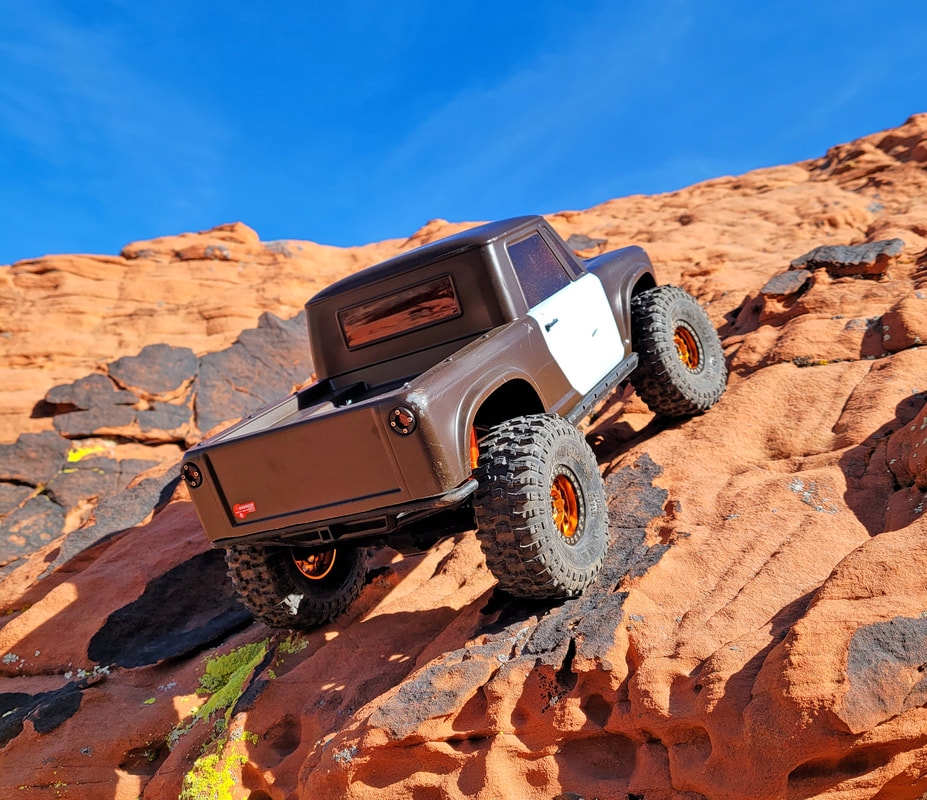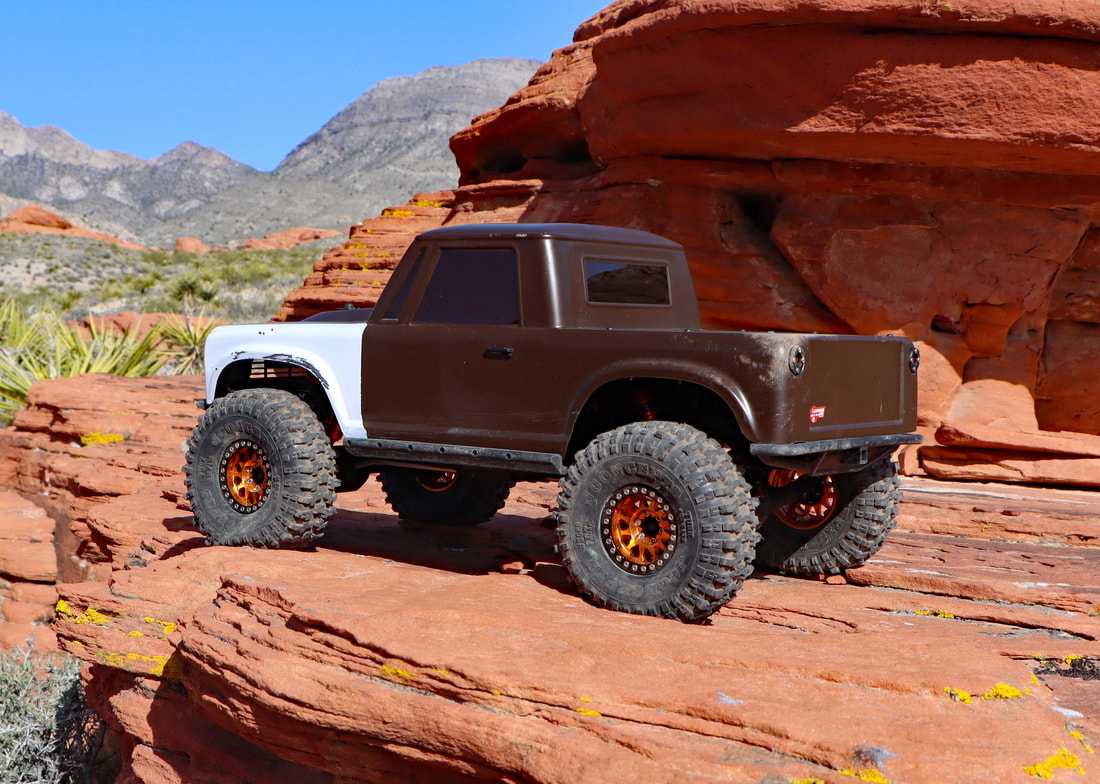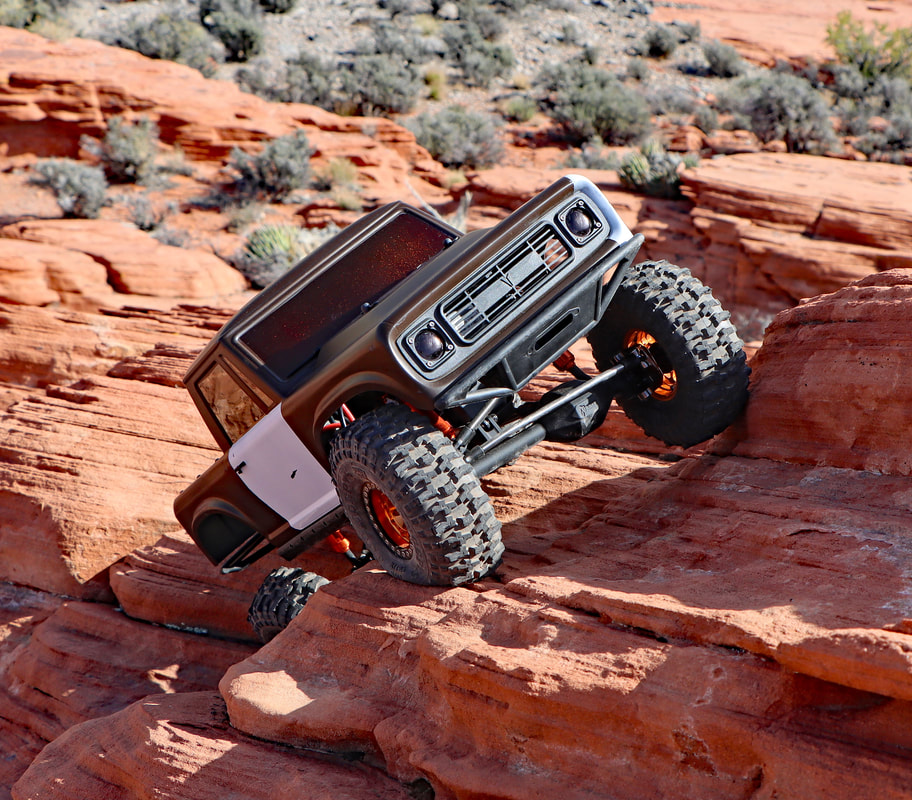JConcepts Tusk 1.9" Performance SCaler Tire
Halfway through 2022 and the RC Crawler market continues to grow with a steady stream of new products in virtually every category. Between tires, motors, ESCs, and even new chassis companies entering the market, we at MVRCA have been quite busy out on the trail testing and evaluating some of these new offerings.
After publishing the JConcepts Ruptures 1.9” crawler tire review, I wanted to stay with JConcepts product line and complete a few more tire reviews from their 1.9” crawler lineup before jumping back into the 2.2” market. To get the ball rolling, I reached out to JConcepts and requested a set of their new Tusks 1.9” Performance Scaler crawler tires for review.
With Tusk tires on the way, I headed back into the shop where the Vanquish VS 410 Pro was sitting on the lift waiting to have much of its original layout restored. The VS 410 Pro is a special truck, and currently a stand-alone review is underway highlighting VS 410 Pro’s unique features and details, with a focus on how we have set this one up.
After publishing the JConcepts Ruptures 1.9” crawler tire review, I wanted to stay with JConcepts product line and complete a few more tire reviews from their 1.9” crawler lineup before jumping back into the 2.2” market. To get the ball rolling, I reached out to JConcepts and requested a set of their new Tusks 1.9” Performance Scaler crawler tires for review.
With Tusk tires on the way, I headed back into the shop where the Vanquish VS 410 Pro was sitting on the lift waiting to have much of its original layout restored. The VS 410 Pro is a special truck, and currently a stand-alone review is underway highlighting VS 410 Pro’s unique features and details, with a focus on how we have set this one up.
|
With that said, one of the reasons for restoring the VS 410 Pro is that while we were able to climb unbelievably steep and technical lines while running the Ruptures ( still the best all-out crawling tire we’ve tested to date ), the changes made to the truck for climbing performance had resulted in it losing much of the “Vanquish” curb appeal, drifting a bit far from the original scale-crawler layout for our liking.
There is no question that the custom sliders, bumpers, light-weight body, trimmed frame, and droop suspension made it a beast of a crawler, but it didn’t feel or look like a Vanquish truck. Knowing that the VS 410 Pro would be doing the lion’s share of tire testing, I wanted to run the VS 410 Pro more as a standard scale truck to compliment the “scale” aspect and performance design of the Tusk tires. This meant reinstalling the original bumpers, sliders, and a new Bronco body. |
A new set of chassis rails were also used since we bobbed the original set. The suspension was changed back from running as a full droop setting to a 70% sag with external springs. Of course the other tuning and weight adjustments tricks remained in play under the hood including custom Ti links from In the Works RC, but the truck was still running the VFD transmission, brushed 540 motor, and chassis mounted servo.
In addition to using the VS 410 Pro truck, we also had plans to mount the Tusks on our Losi Worm (Losi Night Crawler), just to see just how far we could push them on the steep technical rock. With that said, it’s time to jump into the details of the JConcepts Tusk 1.9” tire.
In addition to using the VS 410 Pro truck, we also had plans to mount the Tusks on our Losi Worm (Losi Night Crawler), just to see just how far we could push them on the steep technical rock. With that said, it’s time to jump into the details of the JConcepts Tusk 1.9” tire.
|
Tusk Details
Chunky and gnarly, the JConcepts Tusks capture the look of an aggressive rock crawling / rock bouncing tire. Featuring massive lugs, a bold V-shaped center tread, and wide tread spacing, these tires would be well suited for jagged rock as well as deep mud or sand. Staying with their same soft rubber compound, the Tusks have a soft pliable feel to the underlying carcass, with a firmer feel around the top corner of the tire due to the thick sidewall lugs. There are cuts breaking up the sidewall lugs which aid in the flexibility of the tire without reducing traction in loose conditions. |
These sidewall lug cuts are most commonly found on crawling tires and not dedicated high-RPM rock bouncing tires. It’s a small detail, but important to note because these will indeed provide more flex in the upper area of the sidewall for improved crawling performance.
|
In terms of tire construction, the attention to detail is impressive. The edges of the lugs are crisply molded with almost no molding flash present on any of the four tires provided.
The Tusk is a directional tire with a mirrored image forming the two sides. A detailed tread pattern extends well down the sidewall, terminating in a decorative ring at the midway point of the tire. Underneath is a raised molded company name, tire name, and part number. The beads are firm and well formed, making these tires easy to mount on aluminum beadlock wheels. |
|
Foams
For this test, I decided to try the Ottsix Air-Down two-stage foams. I had been interested in these foams for a while, and the Tusk tire evaluation seemed like a great chance to give them a whirl. I picked up the foams from RPP Racing for $20 per pair, and with a few other times on the large order I was able to get free shipping. That’s a pretty good price considering the CI foams run $26 per pair. The Halo foams are a bit unusual looking, with the narrow closed-cell inner ring seeming to be undersized when compared to a large, open-cell foam outer ring which actually feels a bit more like a scouring-pad plastic material than traditional open-cell foams. As weird as they look, installing them was not terribly difficult and the end result was rather excellent. They have the perfect amount of tire sag at rest and some very good support down the middle. They actually look like a perfectly “aired down” 1:1 tire; Ottsix nailed the description. |
On that purchase order I selected a number of offerings from the Halo line, including the Ultra Air-Down foams. When I installed the Ultra Air-Down foams, they immediately felt too soft for the VS 410 Pro’s weight. I think if these tires were going to be dedicated to a lighter weight rig, then I would have probably started with the Ultras.
|
|
Losi Worm – Out on the Trail
The first few testing runs for the Tusk tires were conducted with the Losi Worm. Officially known at the Losi Night Crawler, I chose this truck to lead off the testing because it’s the most capable crawler in the fleet in terms of steep, slick climbs. It will also do an excellent job of breaking-in the tires without causing excessive wear and tear. |
Starting off the first morning of testing, I ran the Worm along a number moderately difficult trails to break-in the Tusk tires and develop a feel for their side-hill control. Not surprisingly, the Tusks gobbled up the rocks and made short work of a number of off-camber lines. After two battery packs, the lugs had just started to slightly fray and show a dull, roughed-up finish which indicates that any traces of oil or mold release agent has been worn away from the tops of the lugs. This leaves a fresh, sticky rubber on the surface of the tire, making them ready for some difficult lines.
|
With the tires ready for the second day of testing, I headed over to the Secret Menu trail, looking to see if the Tusk tires could handle one of the most difficult trails found on the eastern side of Badrock Ridge.
Secret Menu trail has two entrances; the lower half which only a handful of trucks have ever made it up, and the upper half, while still difficult, is possible for well-built trucks. To get warmed up, I stared on the upper half of the trail to see just how well these Tusks would stick to a steep, moderately eroded rock. |
|
Not surprisingly the Worm easily made its way right up the trail with only a slight pause on the throttle to maintain a good, straight line and controlled crawl on the final push to the top.
Often times on IG you’ll see drivers smash the throttle in hopes that something catches, but that’s more a rock bouncing technique rather than demonstrating the truck’s ability to crawl. Just about any knobby tire will catch at high RPM, but it’s only the high-quality tires and a properly set up crawlers that can get to the top at slow, controlled speeds.
Often times on IG you’ll see drivers smash the throttle in hopes that something catches, but that’s more a rock bouncing technique rather than demonstrating the truck’s ability to crawl. Just about any knobby tire will catch at high RPM, but it’s only the high-quality tires and a properly set up crawlers that can get to the top at slow, controlled speeds.
|
|
As for the lower half, it starts off not really as a trail, but more a narrow ribbon of rock fractured and cleaved off from the side of a larger block, providing little more than a knife-edged ridge for the truck’s right side set of tires to seize. At that point, the truck's axles span a gap, forcing the left-side set of tires to drive its side lugs into a sheer rock wall.
It’s actually quite a terrible trail. Sure there are a few chunks of rock at the bottom to get you started, but it’s fool’s gold at best. Most trucks are on their side within the first two feet of the climb. |
If by chance the truck works its way past this lower section, the next section sweeps you up into a very steep and chunky canyon with a few different exits at the top. By the time your truck is at this juncture, it’s well above your head and out of arm’s reach. You either commit to making it up and over or have your catcher’s mitt out and ready. One slip and the truck is coming down in a big hurry.
With the Worm looking up from the bottom of the lower trail, I slowly spun up the Brood outrunner motor and set up my line to place the right tires dead even on the rock spine. Usually I’m taking photos for this, but I felt it critical to film this trail in order to clearly demonstrate the difficulty of the line and the Tusk’s ability to handle the task at hand.
Rather than commenting on the video in detail, I feel it better to focus on the results in that not only did the Worm clear this difficult lower section, but the Tusks held enough traction to prevent the crawler from slipping off to the right of the rocks.
There is a considerable amount of force applied to the left tires of the truck, and this is what usually gets people in trouble. Trucks tend to slide off to the right side with the left tires dropping down into the gap, and that’s the end of their attempt, punctuated by a fresh scratch on their body. In this video you can see the Tusks do slip and claw for traction, especially on a few of the lower pieces of rock, but they hold the direction of travel and keep the truck moving upwards.
With the Worm looking up from the bottom of the lower trail, I slowly spun up the Brood outrunner motor and set up my line to place the right tires dead even on the rock spine. Usually I’m taking photos for this, but I felt it critical to film this trail in order to clearly demonstrate the difficulty of the line and the Tusk’s ability to handle the task at hand.
Rather than commenting on the video in detail, I feel it better to focus on the results in that not only did the Worm clear this difficult lower section, but the Tusks held enough traction to prevent the crawler from slipping off to the right of the rocks.
There is a considerable amount of force applied to the left tires of the truck, and this is what usually gets people in trouble. Trucks tend to slide off to the right side with the left tires dropping down into the gap, and that’s the end of their attempt, punctuated by a fresh scratch on their body. In this video you can see the Tusks do slip and claw for traction, especially on a few of the lower pieces of rock, but they hold the direction of travel and keep the truck moving upwards.
|
On the upper half of the trail where the upper and lower lines converge, the canyon walls fold in tight and offer a few options for exit.
Due to the low clearance of the Worm, I’m forced to climb up a steep wall on the left side and rotate the truck around the top edge to prevent high centering on the crest. Any other direction and the Worm’s skid will catch on the top edge of the rock, flipping it over backwards for a rather unpleasant tumble back down. |
|
As you can see in the video, the steep angle greatly reduces traction for the front tires, but there is still enough feature to the rock’s surface for the Tusks to grab hold and prevent the front of the truck from sliding off to the side. That said, the rear tires are doing most of the work.
|
|
The final challenge facing the Worm was a small sandstone outcropping featuring a highly technical climb.
This eroded block is steep and heavily textured with many weathered undercuts, but the surface is surprisingly slick with loose bits of sand constantly peeling away from the main rock. It is a frustrating climb at times because the last quarter rises up and to the left, with inconveniently placed smooth undercuts which seem to grab the rear tires and hold them in place. |
As of this writing, only a few trucks have made this short climb, and all were running Ruptures for the attempt. Weirdly, no other tire has made it to the top of this trail.
With my hopes up high, the Worm heading up the steep incline, slipping and clawing its way for elevation. It took a bit of time, but I was able to get the Worm to the top. I was surprised that the Tusks were able to hold traction, so I filmed the second attempt just to be sure it wasn’t a fluke. Like the previous attempt, the Worm skipped and hopped around some, but eventually the tires found their traction and the Worm again summited this difficult line.
I ended the day with a few more steep climbs with the Worm, feeling highly confident in the next round of testing after we move the Tusks over to the VS 410 Pro.
With my hopes up high, the Worm heading up the steep incline, slipping and clawing its way for elevation. It took a bit of time, but I was able to get the Worm to the top. I was surprised that the Tusks were able to hold traction, so I filmed the second attempt just to be sure it wasn’t a fluke. Like the previous attempt, the Worm skipped and hopped around some, but eventually the tires found their traction and the Worm again summited this difficult line.
I ended the day with a few more steep climbs with the Worm, feeling highly confident in the next round of testing after we move the Tusks over to the VS 410 Pro.
|
VS 410 Pro - Out on the Trail
With the Worm testing complete, it was time to move the Tusks over to the recently reworked VS 410 Pro and hit additional areas at Badrock Ridge. If you have had the chance to read any of the crawling articles on this page, you’ll have come to understand the unique and special terrain Badrock Ridge has to offer. The trails at Badrock have the perfect blend of technical climbs, chunky rock, and winding paths through acres of bright red sandstone. Starting off on the lower section where the trails run through narrow canyons littered with rock fragments and fine deposits of red sand, the VS 410 Pro cruised effortlessly along the terrain. The large lugs of the tires propelled the truck over the sandy deposits and carried the weight up and over rock fragments. |
|
As the trail climbed up from the desert floor, the red sandstone steepened quickly with the Tusk tires working diligently to keep the truck moving along.
In this area there is a large sandstone block with a sweeping right side, offering plenty of opportunity to test sidehill performance and overall traction. It takes a few moments to work through a series of cuts and dips in the trail before you reach the top section of rock where the sidehill trail begins. This trail is not particularly difficult, but most importantly the tires need to stick to the rock rather than slide. Even if the truck remains upright, sliding down to the side will have you dropping off the edge into a nasty rock-strewn bottom landing. |
|
Creeping along at a slow speed, the VS 410 Pro had no trouble holding a precise line on the rock, and I attribute some of this control to the generous spacing in between the Tusk’s chunky lugs.
The wide spaces between the flats allowed the rock to poke into the tread pattern, causing the sides of the lugs to hold tight to the rock’s edge, somewhat like a slot car on a track. With the Halo foams providing stability with plenty of tire flex, the Tusks easily handled the steep angle while working along the trail. Moving on to steeper section of the trail, the Tusks exhibited superb traction on the slick rock with their soft rubber compound. Between the softness of the tire and the aggressive tread pattern, the VS 410 Pro made it to the top of every trail we tackled. |
|
Along the way we found ourselves confronted with a tricky section of eroding sandstone slabs sitting atop a very large and tilted sandstone base.
We poked around for a bit on this rock until we found a slippery but possible line to the top. What you cannot see from the camera view is the steepness of this rock because the camera itself is set up at an angle on the same rock, so it gives the impression that the truck is struggling up a simple step-up on the trail. |
|
In reality, the truck is already climbing a significant incline, and this slab is lifting the truck’s nose high in the air and challenging its traction on the surface.
After a few passes, we had the line figured out well enough to record a video. In the first video you can see the close-up detail of the bits of sand peeling away underneath the tire as it churns along looking for traction. The superb control of the brushed motor and plush suspension setup keep the VS 410 Pro well planted and stable while it works its way along until the tires catch hold and propel the truck up the rock.
The Tusk’s pliability and traction with the Halo foams is about as good as it gets for a 1.9” crawling tire. Absolutely superb twisting and folding of the tread's contact patch without losing any sidehill support or grip on the rock’s surface is on full display in this video.
After a few passes, we had the line figured out well enough to record a video. In the first video you can see the close-up detail of the bits of sand peeling away underneath the tire as it churns along looking for traction. The superb control of the brushed motor and plush suspension setup keep the VS 410 Pro well planted and stable while it works its way along until the tires catch hold and propel the truck up the rock.
The Tusk’s pliability and traction with the Halo foams is about as good as it gets for a 1.9” crawling tire. Absolutely superb twisting and folding of the tread's contact patch without losing any sidehill support or grip on the rock’s surface is on full display in this video.
|
|
In the second video, you’ll have to forgive our cameraman’s bobbing and weaving, but you will get a better perspective as to the angle of the rock in this video.
|
|
Further Testing
The remainder of the crawling sessions were very much the same with a high level of consistent, confident performance from the Tusk tires. These tires were perfectly suited for our slick, sandstone rock formations and chunky rock deposits. We continued testing the Tusk tires for another three months, running a total of 53 battery packs through the VS 410 Pro, and by the end of the testing I had come to the conclusion that these are indeed a marvelous tire option for crawling. The Tusks have no negative traits, and that’s somewhat unusual. |
In the past I have found that while a tire may excel on one surface, they will lack in another. This is not the case with the Tusk tires; they had no trouble managing the different rock types in our crawling area.
That said, it’s important to keep in mind that all of our testing was focused on our dry, rocky terrain. I have no idea how they will perform in wet or slick conditions. I cannot see them struggling in mud or wet sand, but mossy or wet hard rock is an unknown.
That said, it’s important to keep in mind that all of our testing was focused on our dry, rocky terrain. I have no idea how they will perform in wet or slick conditions. I cannot see them struggling in mud or wet sand, but mossy or wet hard rock is an unknown.
|
Summary
Heading into this review, I had assumed the Tusks would not be able to offer anything close to the performance or capabilities of Ruptures, but halfway through the testing process I was surprised see to just how close they are to matching the Ruptures. I came to this opinion after scaling a number of impressively difficult climbs that we’ve been doing with the Rupture tires. It was only on very slick, steep lines that the Tusks gave up a bit of performance to the Ruptures, but everywhere else the Tusks were able to get both test trucks to the top. On the Vanquish VS 410 Pro, the Tusks compliment the prominent level of performance the VS 410 Pro is capable of. |
If we consider the Tusk among the other JConcepts 1.9 tires in their Off-Road / Crawler lineup, I see the Tusks holding the number two position, just behind the venerable Ruptures. They are a more aggressive and capable tire than the Landmine, and more dynamic than the Scorpio tires. Knowing that the Ruptures are not permitted in 1.9” competition crawler classes, the Tusks are the obvious choice for many drivers.
At the end of all this testing, there is still a considerable amount of tread life remaining on the tires. Often times the downside to excellent tire performance is a short life span, but these tires seem to be holding up quite well in spite of the heavy use.
For the time being we are going to keep these tires mounted up with the foam and wheel selection, and most likely will run them until the treads are completely worn off.
At the end of all this testing, there is still a considerable amount of tread life remaining on the tires. Often times the downside to excellent tire performance is a short life span, but these tires seem to be holding up quite well in spite of the heavy use.
For the time being we are going to keep these tires mounted up with the foam and wheel selection, and most likely will run them until the treads are completely worn off.
|
Punchline
The JConcepts Tusk Performance Scaler tires are an excellent option for any crawler looking to achieve superb performance on technical rock and challenging trails. The rubber quality and tire design details are consistent with other high-quality offerings from JConcepts, so if you had to pick a single tire from their product line, it’s an easy decision to pick the Tusks. As a bonus, these tires are legal for a number of 1.9” crawler competition classes. |
Evaluation Results
Technical Rock: 30/30
Large Slab ( Slick Rock ): 19/20
Tire Construction Quality and Appearance: 20/20
Rubber Compound: 20/20
Tread Life: 5/5
Versatility: 5/5
Total Score: 99/100
Technical Rock: 30/30
- Tusks feel tailor-made for technical rock crawling. There is not a single weakness in their performance, not an area where we felt they could be better. These tires are more capable than the trucks we tested them on, and our VS 410 Pro can handle some seriously difficult lines.
Large Slab ( Slick Rock ): 19/20
- The only reason these tires don’t score a 20/20 in this category is that there are some tires which just ever so slightly outperform the Tusks on our most daunting slick-rock trails. Trails like 10 Rock are just a bit too much for the Tusks, but that’s about it. They were able to work their way up just about everything else we challenged them with.
Tire Construction Quality and Appearance: 20/20
- Easily the best-looking tire in JConcept’s lineup of crawler tires. Superb molding detail, excellent design to the tread pattern, flawless bead molding, and perfect carcass thickness. Robust and flexible, this level of quality is really the benchmark in the RC crawler tire industry.
Rubber Compound: 20/20
- JConcepts green rubber compound is one of the very best we have tested. It’s sticky, pliable, and performs well under a wide range of temperatures.
Tread Life: 5/5
- Honestly, we really didn't care in this regard due to their absolutely dominant performance out on the trail. That said, they are holding up quite well with only minimal wear on the edges.
Versatility: 5/5
- Where would you not want to drive these? If I’m going to Badrock Ridge and can only pick one set of tires, it’s these and it’s an easy decision.
Total Score: 99/100
Pros
Cons
Specs
- Excellent attention to detail in every aspect of the design.
- Soft rubber compound provides superb traction.
- Large lugs handle loose rock and dirt.
Cons
- They can be hard to find at times.
Specs
- JConcepts Tusk Performance Scaler Tire
- Part Number: 3022-02
- Weight: 62 grams per tire.
- Rubber Material: Super Soft Compound
- Directional: Yes
- Size: 4.75” ( 120mm )
- Retail Price: $25.00 per pair.
Test Crawlers
Vanquish VS 410 Pro
Losi Night Crawler ( Losi Worm )
Vanquish VS 410 Pro
- Castle Copperhead 10 / Brood Racing Creep Brushed Motor
- Reefs 444 Servo
- 3s Lipo Battery
- Driving Weight: 2850 grams
Losi Night Crawler ( Losi Worm )
- Castle Copperhead 10 / Brood Riot 1600 kv Brushless Motor
- Reefs 422 Servo
- 4s Lipo Battery
- Driving Weight: 1900 grams
Published 5/3/2022
Author’s Notes
I have absolutely no financial ties with nor support from the following companies, meaning I pay full retail for their products.
JConcepts provided these tire for the review, but were not involved any further in testing details or results documentation.
I have absolutely no financial ties with nor support from the following companies, meaning I pay full retail for their products.
- Ottsix Racing
- Team Brood Motors
- Dlux Fab
- Reefs
- Castle RC
- RPP Hobbies
JConcepts provided these tire for the review, but were not involved any further in testing details or results documentation.
